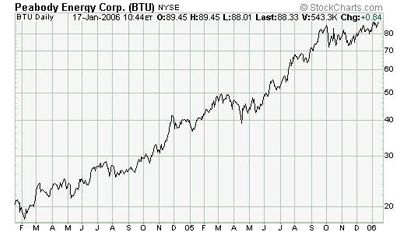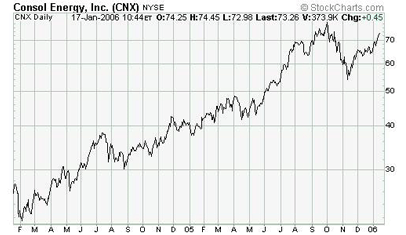| Home | About Us | Resources | Archive | Free Reports | Market Window |
How To Buy Growth StocksBy
Wednesday, January 18, 2006
Dr. Steve Sjuggerud’s note: As you read today’s email, I’m getting settled in Australia, where I’ll be based for a few months. Today’s essay is from my friend Porter Stansberry. Porter seems to have a magic touch when it comes to finding winning stocks... no matter what the general market is doing.
They're the sirens of investing. The supermodels of finance. They are the hopes and dreams of almost every common stock investor... I’m talking about hyper-growth stocks. The kind that go from $5 to $50 in a year. The kind of stocks that make their backers veritable fortunes, almost overnight. The kind of stocks people lust over, like teens reading the Sports Illustrated swimsuit issue. And, like everything else you lust for, growth stocks usually aren’t good for you. Without a lot of discipline (and a little knowledge) most investors will end up wishing they never reached for the brass ring. For every Yahoo!, eBay and Google, there are dozens, if not hundreds, of growth stocks that never made it. And for every Mark Cuban (who made a fortune with tech stocks) there thousands (if not millions) of investors who were wiped out when the story stocks they believed in failed. In today’s letter, I’ll show you how to avoid the big losses most investors suffer in growth stocks... and the best way to buy the kind of stocks that can rise over 100% in months. To avoid the big loss, the first rule of growth stock investing is: Never too much, never too long. The biggest mistake individual investors make is putting too much money into an individual stock. When it comes to investing in growth stocks, cut your usual investment size in half. They’re too risky for big positions. And don’t invest everything in the first slug. Start with half a position, and buy more only if the stock begins to move in your direction. Think about it: if you’ve got the next JDS Uniphase or eBay, does it matter if you bought your position at $2.50 or at an average price of $5? Nope. When hyper-growth stocks work, they move higher quickly. And they keep moving. Don’t tolerate stagnation. If a company’s new widget is supposed to conquer the world, that’s fine. Just make sure you know by when. If it doesn’t happen by the date you set, move on. Remember: Never too much. Never too long. And if you can’t handle the discipline, don’t make the investment. Now... if you’ve got the first rule down and you’re committed to following it, it’s time to go shopping for hyper-growth... Let’s begin with an example. Online banking technology provider Digital Insight (DGIN) had all the hallmarks of a hyper-growth stock when I recommended it in my newsletter in October of 2004... and we still hold this stock in our model portfolio. In short, Digital Insight provides banks with the technology that allows customers to do things like check their balance and pay their bills online. The company was spending about $12 million a year to maintain and operate its data and networking systems. But after Digital Insight spent that money, it could add additional users at virtually no cost... The more customers it added, the higher the profit margins... and the more money it was going to make... So, all I had to do is figure out whether or not more people were likely to begin banking online. For me, the question was a no-brainer. First, paying your bills online is free with most checking accounts. Second, using the online bill pay service eliminates most of the time and hassle of a chore every single family in America faces each month. In the first nine months of 2005, Digital Insight’s revenues grew to $157 million, up $18 million from 2004 - an increase of 12.9%. But the company's operating costs only increased by $10 million. Thus, operating income grew $28.6 million, from $21. 4 million -- a 33% increase. That's scalability: the bigger the company gets, the larger its operating margins become. Companies that have these kinds of high fixed costs are often mispriced by the stock market because they tend to lose a lot of money during the start-up phase. The high fixed costs that make the business scalable can be difficult to finance and may lead to bankruptcy if sales don't ramp up quickly. Even after they reach profitability these businesses tend to be mispriced by the stock market because most investors don't appreciate how big operating margins can become with additional revenue. In just one year, Digital Insight has increased its operating margin from 15% to 24%. And, if sales continue to grow... so will margins. That's why the stock price has advanced from less than $13 to over $37 in just over one year. To summarize, these are the four hallmarks I always look for in a hyper-growth stock, and the reasons I picked Digital Insight: 1. Sustainable sales growth: This is easy to find and makes sense to any investor 2. High operating margins: The profit from each widget today has to pay for the development of future widgets... and leave enough left over to enrich shareholders. 3. Small capital requirements: We don’t want to see all the profits going out the door to pay off big debts. 4. And -- most importantly – scalability: We want companies that can handle many additional users at no extra cost. In tomorrow’s DailyWealth, I’ll introduce you to a company that meets all of these criteria. In fact, this company has more scalability than any company I have ever seen. It’s one of my top picks for 2006... be sure to check it out. Good Investing, Porter Stansberry Market NotesANOTHER BUY SIGNAL FOR COAL? If forecasts from the world’s biggest electrical equipment makers are any indication, the bull market in coal may have plenty of room to run. Although coal is seen as the ugly, dirty cousin of the energy complex, huge electrical firms like General Electric and Siemens are projecting the world is leaning back towards coal as a preferred fuel source for electricity generation. As Europe learned with Gazprom this month, relying on the tight natural gas market can be risky. As the Financial Times reported on Monday: “Independent forecasts from France's Alstom and Germany's Siemens, made available to the Financial Times, show that about 40 per cent of the orders for electricity turbines in the next decade will be for coal-powered units, with the share of gas-fired plants falling to between 25 per cent and 30 per cent.” In other words, coal demand is likely to remain high… and two of the largest coal producers, CONSOL Energy (CNX) and Peabody Energy (BTU) are resuming their uptrends. The past two years in CNX and BTU:

|
Recent Articles
|


